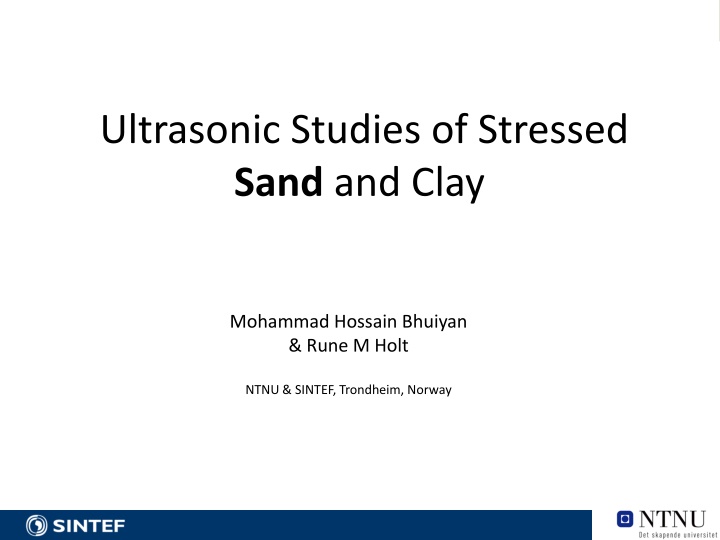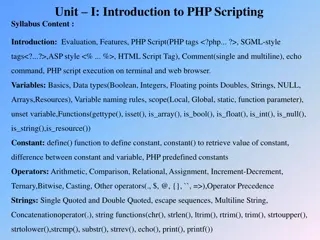
Ultrasonic Studies of Stressed Sand and Clay Analysis
Research on the effects of fluid substitution on anisotropic parameters in stressed sand and clay, exploring the behavior of vp/vs, limitations of known trends for unconsolidated sediments, and the impact of fluid substitution on anisotropy. Laboratory tests in a triaxial setup with Ottawa sand, measuring multi-directional P- and S-wave velocities, and determining elastic stiffness parameters. Investigation into the impact of fluids on epsilon under uniaxial strain conditions, considering different stress and saturation levels.
Download Presentation

Please find below an Image/Link to download the presentation.
The content on the website is provided AS IS for your information and personal use only. It may not be sold, licensed, or shared on other websites without obtaining consent from the author. If you encounter any issues during the download, it is possible that the publisher has removed the file from their server.
You are allowed to download the files provided on this website for personal or commercial use, subject to the condition that they are used lawfully. All files are the property of their respective owners.
The content on the website is provided AS IS for your information and personal use only. It may not be sold, licensed, or shared on other websites without obtaining consent from the author.
E N D
Presentation Transcript
Ultrasonic Studies of Stressed Sand and Clay Mohammad Hossain Bhuiyan & Rune M Holt NTNU & SINTEF, Trondheim, Norway
Motivation Explore the effect of fluid substitution on anisotropic parameters Explore the behavior of vp/vsfor sand and clay How well known vp/vstrends does not works for uncosolidated sediments? Impact of fluid substitution on Anisotropy? (Collett & Gurevich, 2013; Thomsen, 2012)
Lab tests in triaxial set-up (only unsorted Ottawa sand) 20 Saturated Dry Stress/Pressure (MPa) Axial stress Confining pressure Pore pressure 16 12 8 4 0 0 10 20 30 40 Time (Hours) Saturated with 3,5wt% NaCl Multi-directional P- & S-wave velocity measurements permit determination of all 5 TI elastic stiffness parameters => Thomsen's (+ )
Effect of fluid on Epsilon (Uniaxial strain condition) 0.1 0.05 Epsilon 0 -0.05 dry -0.1 0 4 8 12 16 Net vertical stress (MPa) OT_Dry (US); Experiment (TTS)
Effect of fluid on Epsilon (Uniaxial strain condition) 0.1 0.05 Epsilon 0 Sat -0.05 dry -0.1 0 4 8 12 16 Net vertical stress (MPa) OT_Saturated (US); Experiment (TTS) OT_Dry (US); Experiment (TTS)
Effect of fluid on Epsilon (Uniaxial strain Condition) 0.1 0.05 Epsilon 0 Sat -0.05 dry -0.1 0 4 8 12 16 Net vertical stress (MPa) OT_Saturated (US); Experiment (TTS) OT_Dry (US); Experiment (TTS) OT_Dry (US); plus Isotropic Gassmann (TTS)
Effect of fluid on Epsilon (Uniaxial strain Condition) 0.1 0.05 Epsilon 0 -0.05 -0.1 0 4 8 12 16 Net vertical stress (MPa) OT_Saturated (US); Experiment (TTS) OT_Dry (US); Experiment (TTS) OT_Dry (US); plus Isotropic Gassmann (TTS) OT_Dry (US); plus Anisotropic Gassmann (TTS)
Effect of fluid on Epsilon (Hydrostatic stress) 0.1 0.05 dry Epsilon 0 -0.05 -0.1 0 4 8 12 16 Net vertical stress (MPa) OT_Dry (HS); Experiments (TTS)
Effect of fluid on Epsilon (Hydrostatic stress) 0.1 0.05 dry Epsilon 0 Saturated -0.05 -0.1 0 4 8 12 16 Net vertical stress (MPa) OT_Saturated (HS); Experiments (TTS) OT_Dry (HS); Experiments (TTS)
Effect of fluid on Epsilon (Hydrostatic stress) 0.1 0.05 dry Dry + Isotropic Gassmann Epsilon 0 Saturated -0.05 -0.1 0 4 8 12 16 Net vertical stress (MPa) OT_Saturated (HS); Experiments (TTS) OT_Dry (HS); Experiments (TTS) OT_Dry (HS); plus Isotropic Gassmann
Effect of fluid on Epsilon (Hydrostatic stress) 0.1 0.05 dry Dry + Isotropic Gassmann Dry + Anisotropic Gassmann Epsilon 0 Saturated -0.05 -0.1 0 4 8 12 16 Net vertical stress (MPa) OT_Saturated (HS); Experiments (TTS) OT_Dry (HS); Experiments (TTS) OT_Dry (HS); plus Isotropic Gassmann OT_Dry (HS); plus Anisotropic Gassmann
Effect of fluid on Gamma (Uniaxial strain condition) 0.12 Dry (US); 1st loading Dry (US); 1st unloasing Dry (US); 2nd loading Dry (US); 2nd unloading 0.08 0.04 Gamma 0 -0.04 -0.08 0 4 8 12 16 -0.12 Net vertical stress (MPa)
Effect of fluid on Gamma (Uniaxial strain condition) 0.12 Saturated (US); 1st loading Saturated (US); 2nd loading Dry (US); 1st loading Dry (US); 2nd loading Saturated (US); 1st unloasing Saturated (US); 2nd unloading Dry (US); 1st unloasing Dry (US); 2nd unloading 0.08 0.04 Gamma 0 -0.04 -0.08 0 4 8 12 16 -0.12 Net vertical stress (MPa)
Effect of fluid on Gamma (Hydrostatic stress) 0.12 Dry (HS); 1st loading Dry (HS); 1st unloading Dry (HS); 2nd loading Dry (HS); 2nd unloading 0.08 0.04 Gamma 0 -0.04 -0.08 0 4 8 12 16 -0.12 Net vertical stress (MPa)
Effect of fluid on Gamma (Hydrostatic stress) 0.12 Saturated (HS); 1st loading Saturated (HS); 1st unloading Dry (HS); 1st loading Dry (HS); 1st unloading 0.08 Dry (HS); 2nd loading Dry (HS); 2nd unloading 0.04 Gamma 0 -0.04 -0.08 0 4 8 12 16 -0.12 Net vertical stress (MPa)
Effect of fluid on Delta (Uniaxial strain condition) 0.1 Dry (US); Experiment 0.05 Delta 0 -0.05 -0.1 Dry -0.15 0 5 10 15 20 Net vertical stress (MPa)
Effect of fluid on Delta (Uniaxial strain condition) Saturated (US); Experiment 0.1 Dry (US); Experiment 0.05 Delta 0 -0.05 -0.1 -0.15 0 5 10 15 20 Net vertical stress (MPa)
Effect of fluid on Delta (Uniaxial strain condition) Saturated (US); Experiment Dry (US); Experiment Dry (US); plus Anisotropic Gassmann 0.1 0.05 Delta 0 -0.05 -0.1 -0.15 0 5 10 15 20 Net vertical stress (MPa)
Effect of fluid on Eta (Uniaxial strain condition) 0.15 0.1 0.05 Eta 0 -0.05 -0.1 Dry -0.15 5 7 9 11 13 15 Net vertical stress (MPa)
Effect of fluid on Eta (Uniaxial strain condition) 0.15 0.1 0.05 Eta 0 -0.05 -0.1 Dry Saturated -0.15 5 7 9 11 13 15 Net vertical stress (MPa)
Effect of fluid on Eta (Uniaxial strain condition) C33 C33 0.15 0.1 0.05 Eta 0 -0.05 Dry Saturated Collet and Gurevich (2013) -0.1 -0.15 5 7 9 11 13 15 Net vertical stress (MPa)
Vp-Vs (sand-clay)
Lab tests in Oedometer Only saturated (sand-clay) 12 saturated dry Stress/Pressure (MPa) 10 8 6 Fluid effects (only sand) 4 Stress (MPa) Pore Pressure (MPa) 2 0 0 100 200 300 400 Time (minutes)
Vp/Vs: Role of fluid (only sand data) >450 m (dry) 355-450 m (dry) 230-355 m (dry) Ottawa sand (dry) 5 Data from Oedoemeter 4 Vp/Vs 3 2 Dry 1 0 5 10 Net Vertical Stress (Mpa)
Vp/Vs: Role of fluid (only sand data) >450 m (dry) >450 m (saturated) 355-450 m (dry) 355-450 m (saturated) 230-355 m (dry) 230-355 m (saturated) Ottawa sand (dry) Ottawa sand (saturated) 5 Data from Oedoemeter 4 Vp/Vs 3 Saturated 2 Dry 1 0 5 10 Net Vertical Stress (Mpa)
Vp/Vs: The role of clay content and stress Data from tests with brine-saturated sand, clay (kaolinite) and sand:clay mixtures 6 Pure sand 25 vol% clay 30 vol% clay 40 vol% clay 50 vol% clay 75 vol% clay Pure clay 5 vP/vSdecreases with stress, more in clay than in sand vp/vs 4 3 Clay shows higher vp/vsthan sand 2 0 3 6 9 Net vertical stress (MPa)
Vp/Vs trends Oedometer tests performed with brine-saturated sand, clay (kaolinite) and sand:clay mixtures have been used to address vPvs. vStrends (here: only axial velocities)
vP/vS: trends for sand 2 >450 m OT 355-450 m OT 230-355 m OT 1.9 <230 m OT Ottawa sand vp(km/s) 450-550 m ColS 1.8 355-450 m ColS 230-355 m ColS 180-230 m ColS 1.7 Han et al., 1986 Castagna et al., 1993 Weighted average (OT) 1.6 0.2 0.4 0.6 0.8 Weighted average (ColS) vs(km/s) Higher velocities for Ottawa than for angular Columbia sand, but similar vP-vStrends Plotting vPvs vSgives a better picture than showing vP/vSalone No obvious effect of grain size
vP/vS: global trends for sand 2.7 The trends are different from data at low stress (< 10 MPa) and above vp(km/s) 2.3 1.9 Data from Zimmer, 2003 (Diamond); Domenico, 1977 (circular), Prasad, 1988 (square); Mondol et al., 2010 (triangle) and Yin, 1992 (star) 1.5 0.2 0.4 0.6 0.8 1 1.2 vs(km/s) Galvestone Beach sand Galf of Maxico sand Santa Cruz I Glass Beads Coarse sand Quartz Arenite-2 Pure Sand 90% sand+10% clay 75% sand+25% clay Han et al., 1986 Suggested trend (unsorted sand, with disp.) Suggested trend (Coarse sand, with Disp.) Meritt sand Pomponio beach sand Santa Cruz II Ottawa sand Fine sand Quartz Arenite-3 95% sand+5% clay 85% sand+15% clay Castagna et al., 1993 Suggested Trend (weighted ave. sand, no disp.) Suggested trend (Fine sand, with disp.) Suggested trend (25% clay)
vP/vS: trends for clays The trends are different from sand + again for data at low stress (< 10 MPa) vs. above 2.9 Kaolinite-1 Kaolinite-2 25% Smectite+75% Kaolinite 75% Smectite-25% Kaolinite Smectite 80% Smectite+20% Kaolinite 60% Smectite+40% Kaolinite 20% Smectite+80% Kaolinite Kaolinite Kaolinite 75% Kaolinite+25% Sand 65% Kaolinite+35% Sand 50% Kaolinite+50% Sand Castagna et al., 1993 Castagna et al., 1985 Mondol et al., 2009 Suggested Trend (Pure clay) Suggested trend (75% clay) Suggested trend (50% clay) 2.4 vp(km/s) Diamonds: This study Squares: Mondol et al. (2009) Circles: Yin (1992) (hydrostatic data) 1.9 1.4 0.2 0.6 1 1.4 1.8 vs(km/s)
Vp/Vs: Role of state of consolidation and clay content 6.5 6.5 1st loading 1st unloading 2nd loading 2nd unloading Sand Sand with 30% kaolinite 5.5 5.5 vp/vs 4.5 vp/vs 4.5 3.5 3.5 2.5 2.5 0 2 4 6 8 10 0 2 4 6 8 10 Net vertical stress (MPa) Net vertical stress (MPa) 6.5 6.5 Pure kaolinite Kaolinite:sand (50:50) 5.5 5.5 vp/vs 4.5 4.5 vp/vs 3.5 3.5 2.5 2.5 0 2 Net vertical stress (MPa) 4 6 8 10 0 2 4 6 8 10 Net vertical stress (MPa)
vP/vS: The role of Stress Path (only for sand) 5 5 Uniaxial strain condition (loading) vp/vsratio 4 4 3 3 2 2 0 3 6 9 12 0 3 6 9 12 15 18 Net mean stress (MPa) Net vertical stress (MPa) Ottawa sand data from triaxial set-up, showing apparent data collapse when vP/vSis plotted against net mean stress
vP/vS: The role of Stress Path (only for sand) 5 5 Uniaxial strain condition (loading) Uniaxial strain condition (unloading) vp/vsratio 4 4 3 3 2 2 0 3 6 9 12 0 3 6 9 12 15 18 Net mean stress (MPa) Net vertical stress (MPa) Ottawa sand data from triaxial set-up, showing apparent data collapse when vP/vSis plotted against net mean stress
vP/vS: The role of Stress Path (only for sand) 5 5 Hydrostatic stress consition (loading) 4 4 vp/vsratio 3 3 2 2 0 3 6 9 12 0 3 6 9 12 Net mean stress (MPa) Net vertical stress (MPa) Ottawa sand data from triaxial set-up, showing apparent data collapse when vP/vSis plotted against net mean stress
vP/vS: The role of Stress Path (only for sand) Hydrostatic stress consition (loading) Hydrostatic stress condition (unloading) 5 5 4 4 vp/vsratio 3 3 2 2 0 3 6 9 12 0 3 6 9 12 Net vertical stress (MPa) Net mean stress (MPa) Ottawa sand data from triaxial set-up, showing apparent data collapse when vP/vSis plotted against net mean stress
Conclusions Comparison between measured dry and saturated anisotropy parameters are conformable with theory within experimental uncertainty vP/vSrelation is sensitive to fluid saturation, stress, lithologies and state of consolidation. Well known vp/vstrends fail to explain vp/vsrelation for uncosolidated sandy lithologies but fairly capture for clayey lithologies.
Acknowledgements ROSE Program at NTNU for financial support J rn Stenebr ten & others in the Formation Physics Laboratory at SINTEF & NTNU






















